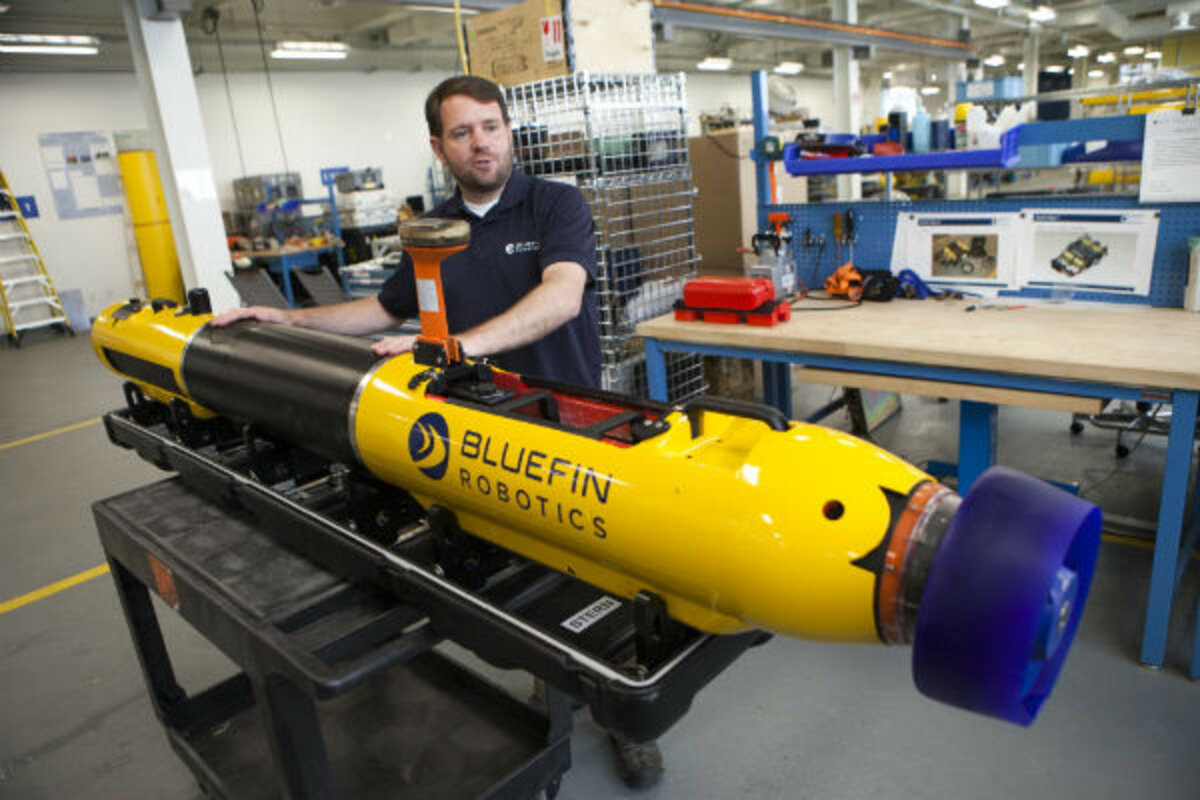Malaysia Airlines Flight MH370: US Navy deploys deep sea drone to aid search
Loading...
| Quincy, Mass.
In the heart of the nation’s oldest shipyard in Quincy, Mass., behind a series of locked doors, engineers at Bluefin Robotics design sea-bound drones that traverse the oceans of the globe, mapping the sea floor as part of oceanographic research, oil and gas exploration, and Defense Department reconnaissance.
This week, the Bluefin-21, one of the company’s signature deep-sea robots belonging to a defense contractor working with the US Navy, arrived in Perth, Australia, ready to aid in the multi-national search for the wreckage of the missing Malaysian airliner MH370.
Flight 370 and its 239 passengers and crew disappeared from air traffic control screens at 1:21 a.m. local time on March 8. Malaysian Prime Minister Najib Razak announced on Monday that the flight likely “ended in the southern Indian Ocean.”
The Australian Royal Navy and the Malaysian government have called all hands on deck in the search for the missing airliner, which was headed to Beijing. The US Navy has answered the call and drafted some of its most advanced deep-sea technology, including anti-submarine aircraft, floating black box locators, and the Bluefin-21.
The 25-ft-long, 21-inch diameter Bluefin-21 resembles a pontoon. Its bright yellow shell – the same shade as the head and hands of a Lego man – comes apart into three sections making it ideal for air transport. The sub has no fins and is instead steered by an articulated propeller on its tail cone.
Bluefin’s director of marine operations Will O’Halloran demonstrates how the modular components fit together on a smaller, 9-inch diameter model. He points to an oil-filled bladder that seals the components and protects the communication systems, guidance controls, removable data storage compartment, and payload from the extreme pressures of the deep sea.
The Navy will be using two different payloads for this mission, a side-scan sonar and an optical camera, Mr. O’Halloran explains.
The drone “flies” 50 meters above the sea floor scanning for anything that may look out of place. Crews above the surface can monitor the sub’s position from the deck of a ship.
When the craft returns to the surface, it sends the crew an email announcing, “I am here,” Mr. O’Halloran says. The crew can swap out the data compartment, “basically a big USB thumb drive,” and the battery before sending it off to continue the search. If the sonar data reveals anything of interest, the crew can swap out the sonar with an optical camera and strobe light in order to get a better view of what’s down there.
Despite the sophistication of the Bluefin-21, the task is enormously daunting, says Bluefin CEO David Kelly.
“We have to search an area the size of Texas that’s 2 ½ miles below the sea surface,” Mr. Kelly says. “It’s pitch black down there” and the pressure at that depth “is equivalent to a Cadillac Escalade balanced on your thumbnail.”
That’s where the Navy’s anti-submarine aircraft and black box detection systems come in.
Two different models of American-made and operated planes designed to detect enemy submarines have been patrolling the skies above the Indian Ocean, Lockheed Martin's P-3 Orion and Boeing's P-8 Poseidon, the Navy’s most advanced maritime surveillance.
The all-weather planes are equipped with a variety of sensors, radar equipment, and both electro-optical and infrared cameras that can scan the surface of the sea in search of floating debris.
During combat missions, these planes typically carry bombs, missiles, and torpedoes. However, for this mission, the planes are equipped instead with sonobuoys, small flotation devices attached to underwater microphones known as hydrophones that “listen” for the ping of MH370’s black box.
This week, as officials have started to narrow the search field, the Navy sent another black box retrieval system known as a Towed Pinger Locator. The so-called TPL-25 can be tethered to the back of a boat and towed along the sea surface with a line connected to a hydrophone dangling up to 20,000 feet beneath the waves.
“The ship just kind of goes back and forth in a search area at about 3 knots [roughly 3.5 miles per hour],” Navy spokesman Chris Johnson says. “We can do about 150 square miles a day that way and listen for that ping. If we get close enough to that ping we should be able to detect it. We’ve got to be within a mile of it, but we should be able to pick it up as long as it’s actually transmitting correctly.”
The Navy has been using variations of the TPL-25 for about 20 years to find the black boxes of both military and commercial aircraft, Mr. Johnson says. A similar device successfully recovered the black box from TWA flight 800 that exploded and crashed into the Atlantic Ocean on July 17, 1996 killing 230 people. It was deployed again in 2009 in search of Air France flight 447, but was not able to recover the black box because it was not transmitting any signals, he says.
Given the duration of the search for flight 370, it is quite possible that the black box’s batteries will run out before the search equipment is able to locate it. Black box batteries typically last 30 days after leaving the plane, Johnson says. That means that they could run out in a little over a week.





